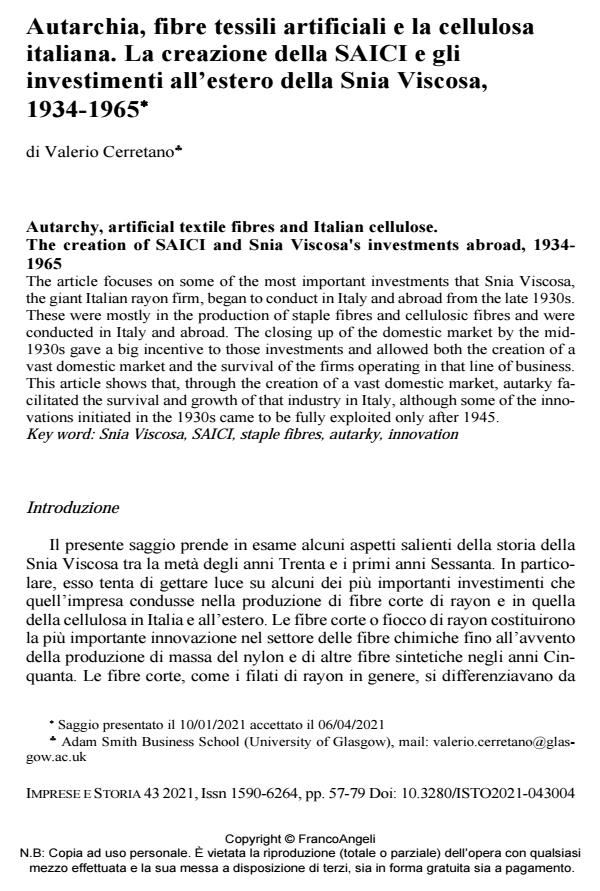Autarchy, artificial textile fibres and Italian cellulose. The creation of SAICI and Snia Viscosa's investments abroad, 1934-1965
Journal title IMPRESE E STORIA
Author/s Valerio Cerretano
Publishing Year 2021 Issue 2021/43
Language Italian Pages 23 P. 57-79 File size 267 KB
DOI 10.3280/ISTO2021-043004
DOI is like a bar code for intellectual property: to have more infomation
click here
Below, you can see the article first page
If you want to buy this article in PDF format, you can do it, following the instructions to buy download credits

FrancoAngeli is member of Publishers International Linking Association, Inc (PILA), a not-for-profit association which run the CrossRef service enabling links to and from online scholarly content.
The article focuses on some of the most important investments that Snia Viscosa, the giant Italian rayon firm, began to conduct in Italy and abroad from the late 1930s. These were mostly in the production of staple fibres and cellulosic fibres and were conducted in Italy and abroad. The closing up of the domestic market by the mid-1930s gave a big incentive to those investments and allowed both the creation of a vast domestic market and the survival of the firms operating in that line of business. This article shows that, through the creation of a vast domestic market, autarky facilitated the survival and growth of that industry in Italy, alt-hough some of the innovations initiated in the 1930s came to be fully exploited only after 1945.
Keywords: Snia Viscosa, SAICI, staple fibres, autarky, innovation
- Acerbo G. (1934). Il problema della produzione nazionale di cellulosa, Roma
- Bermond C. (2005). Riccardo Gualino finanziere e imprenditore, Torino: Giappichelli.
- Bonelli F. Lo sviluppo di una grande impresa in Italia, Torino. Einuadi 1975
- Castronovo V. e Falchero A.M. (2008). L’avventura di Franco Marinotti. Impresa, finanza e politica nella vita di un capitano d’industria. Milano: Cristian Marinotti Edizioni
- Valerio Cerretano. (2012). European cartels, European multinationals and economic de-globalisation: Insights from the rayon industry, c. 1900–1939. Business History, 54:4, 594-622, DOI: 10.1080/00076791.2012.683415
- Cerretano V. (2018). ‘Multinational business and host countries in times of crisis: Courtaulds, Glanzstoff and Italy in the interwar period. Economic History Review, 71 (2), pp.540-66
- Cerretano V. (2020a). Autarky, market creation and innovation: Snia Viscosa and Saici, 1933-1970. Business History. DOI: 10.1080/00076791.2020.175059
- Cerretano V. (2020b). Autarchia e multinazionali:il caso della Snia Viscosa. Ricerche Storiche, 50 (1,2020), pp. 17-40
- Chiapparino F. (1996). Note per una biografia imprenditoriale di Riccardo Gualino. In Bigazzi D, a cura di, Storie di imprenditori, Bologna:il Mulino, pp.357-413
- Chiapparino F. (1989/1990). Il tentativo di concentrazione dell’industria dolciaria negli anni Venti. Gualino e l’Unica. Annali di storia dell’impresa, 5/6 (1989/1990), pp.323-74
- Coleman D.C. (1969-80). Courtaulds: an economic and social history, Vol3: Crisis and change, 1940-1965. Oxford: Clarendon press
- Di Quirico R. (2001). ‘La crisi valutaria del 1935 e la politica economica dell’Italia fascista’. Passato e Presente, 53 (1), pp.72-94
- Fabbroni F e Zamo P. (1973). La SAICI di Torviscosa (1937-1948) – Capitale, fascismo e movimento operaio.Storia contemporanea in Friuli, 3 (4), pp. 11-82
- Federico G., Natoli S., Tattara G., Vasta M. (2011). Il commercio estero italiano, 1862-1950. Bari-Roma: Laterza
- Flint R. (1937). The Lanital position. Silk & Rayon, vol.11, p.148
- Gagliardi A. (2006). L’impossibile autarchia. La politica economica del fascismo e il ministero scambi e valute, Catanzaro: Rubettino.
- Grifone P .(1971). Il capitale finanziario in Italia Torino: Einaudi
- Guarneri F. (1988). Battaglie economiche tra le due guerre. Bologna:il Mulino
- Hirschman A.O. (1987). Potenza nazionale e commercio estero. Gli anni trenta, l’Italia e la ricostruzione. Bologna: Il Mulino
- Joly H (2015). Les Gillet de Lyon. Fortunes d’une grande dynastie industrielle (1838-2015). Genève: Librarie Droz
- Maiocchi R.(2003). Gli scienziati del Duce. Il ruolo dei ricercatori e del CNR nella politica autarchica del fascismo, Roma: Cacucci
- Mantoan, A. (Gennaio-Dicembre 2011). ‘Innovazioni o fallimenti? L’Alfa Romeo e l’autarchia’ . Imprese e Storia, n.41-42, pp. 187-214
- Petri, R (2001). Von der Autarkie zum Wirtshaftswunder. Wirtshaftspolitik und industrieller Wandel in Italien 1935-1963. Tuebingen: Max Niemeyer Verlag
- Petri R.(2002). Storia economica d’Italia. Dalla Grande guerra al miracolo economico (1918-1963). Bologna:il Mulino.
- Ricerche & Studi SpA (Mediobanca). ‘Analisi di società. Società Nazionale Industria Applicazioni -Viscosa, SNIA Viscosa’, Milano, 23 novembre 1971
- Scherner J. (2008). The beginnings of Nazi autarky policy: the ‘National Pulp Programme’ and the origin of regional staple fibre plants. Economic History Review, 61 (4), pp.867-895
- Spadoni, M. (2003). Il gruppo Snia dal 1917 al 1951, Torino: Giappichelli
- Stocking G. and Watkins M.W. (1946). Cartels in action. Case Studies in International Business Diplomacy. New York: The Twentieth Century Fund.
- Stone S. (2002). Saiccor.The First Fifty Years. Cape Town: Taylor G.T and Sudnik P. (1984). DuPont and the International Chemical Industry. Boston: Twayne Publishers.
- Zamagni V, a cura di (1997). Come perdere la guerra e vincere la pace. Bologna: il Mulino.
Valerio Cerretano, Autarchia, fibre tessili artificiali e la cellulosa italiana. La creazione della SAICI e gli investimenti all’estero della Snia Viscosa, 1934-1965 in "IMPRESE E STORIA" 43/2021, pp 57-79, DOI: 10.3280/ISTO2021-043004